Leadership in Health Care: Analysis of a Case Study and Personal Reflection
VerifiedAdded on 2023/06/10
|12
|2987
|97
AI Summary
This article discusses the importance of effective leadership in the healthcare system, analyzing a case study and reflecting on personal qualities of a leader. It covers various leadership styles and characteristics of a leader for providing high-quality care to patients.
Contribute Materials
Your contribution can guide someone’s learning journey. Share your
documents today.
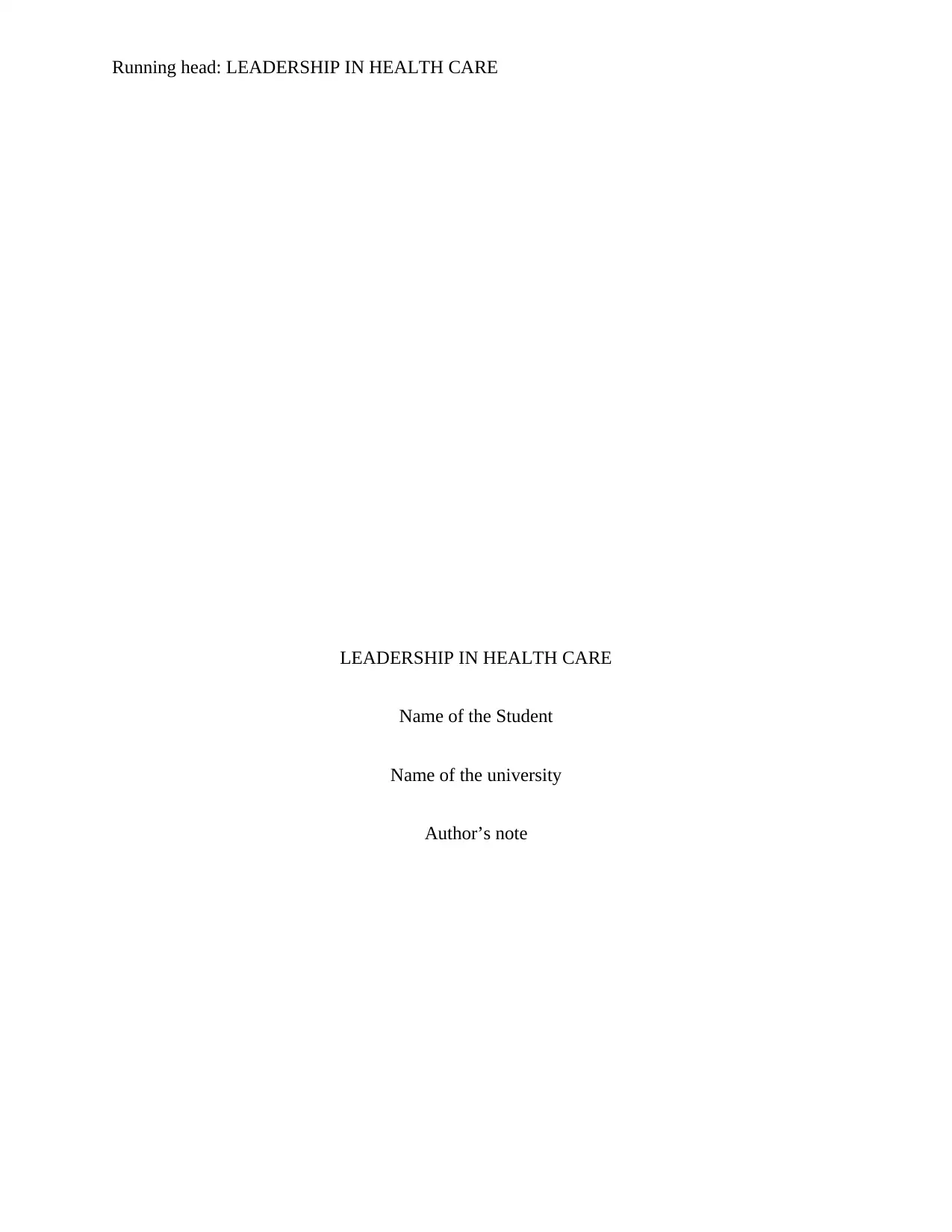
Running head: LEADERSHIP IN HEALTH CARE
LEADERSHIP IN HEALTH CARE
Name of the Student
Name of the university
Author’s note
LEADERSHIP IN HEALTH CARE
Name of the Student
Name of the university
Author’s note
Secure Best Marks with AI Grader
Need help grading? Try our AI Grader for instant feedback on your assignments.

1LEADERSHIP IN HEALTH CARE
Analysis of the scenario
Part 1
The leadership theories are dynamic and are subjected to change with time. The health care
system is dynamic and are composed of numerous professional groups, departments and
specialists having intricate and non-linear interactions with them (Yphantides et al., 2015). The
complications of this robust system is often unparalleled due to the constraints related to
different disease areas, multidisciplinary staffs and the multidirectional goals (Al-Sawai, 2013).
This case study reveals that Helen has been appointed as an influential public health leader,
where she has to be in charge of a diverse, multi-ethnic ageing community, where the remotest
areas lacked specialized services. It has to be remembered that the agenda for the health
planning has been driven by the traditional town planners and the policy makers. Within large
organizations, the policy makers and the town planners might support or can be in conflict with
each other, hence Helen’s leadership needs to be capitalized within the system as a whole such
that the resources of the organization can be used efficiently.
Furthermore Helen is a 35 years old lady and a popular GP and she is working in a
situation where the community is not open to young female leaders, hence it is the duty of the
leader to make them understand that leadership is not determined by the gender, but by the trait
and the capability to foster positive changes (Henry et al., 2015). According to Batool (2013),
practical knowledge is essential in health care but according to the experts emotional intelligence
is also necessary for improving the perception. According to a study by Goodwin, (2013), it has
been found that emotional intelligence of women are effective than that of the male. It has to be
Analysis of the scenario
Part 1
The leadership theories are dynamic and are subjected to change with time. The health care
system is dynamic and are composed of numerous professional groups, departments and
specialists having intricate and non-linear interactions with them (Yphantides et al., 2015). The
complications of this robust system is often unparalleled due to the constraints related to
different disease areas, multidisciplinary staffs and the multidirectional goals (Al-Sawai, 2013).
This case study reveals that Helen has been appointed as an influential public health leader,
where she has to be in charge of a diverse, multi-ethnic ageing community, where the remotest
areas lacked specialized services. It has to be remembered that the agenda for the health
planning has been driven by the traditional town planners and the policy makers. Within large
organizations, the policy makers and the town planners might support or can be in conflict with
each other, hence Helen’s leadership needs to be capitalized within the system as a whole such
that the resources of the organization can be used efficiently.
Furthermore Helen is a 35 years old lady and a popular GP and she is working in a
situation where the community is not open to young female leaders, hence it is the duty of the
leader to make them understand that leadership is not determined by the gender, but by the trait
and the capability to foster positive changes (Henry et al., 2015). According to Batool (2013),
practical knowledge is essential in health care but according to the experts emotional intelligence
is also necessary for improving the perception. According to a study by Goodwin, (2013), it has
been found that emotional intelligence of women are effective than that of the male. It has to be

2LEADERSHIP IN HEALTH CARE
remembered that apart from being an influential health care leader, Helen is also a G.P, and
hence her sole duty as a doctor is to deliver a quality patient care. Emotional intelligence is also
necessary to overcome obstacles and resolve conflicts by the resistors and the blamers. It can
already been seen that Helen has already played the part of a leader by increasing the
immunization rates and increasing the awareness regarding the cancer screening. It has to be
remembered that an idea leader should be interested in producing the kind of civic engagement
that is dedicated to change to organizing the actions for improving the life of the community (Al-
Sawai, 2013). They are mainly the citizen leaders and focus on the community health rather than
individual health problem Health Workforce Australia., 2013). The case study also reveals the
unequal access to health care that the people living in the remotest areas have been facing for so
long, hence as a leader Helen can make comprehensive plans such as provision of dispensaries in
the remotest areas or give access to the lifesaving medicines at low cost.
The case study reveals that Helen is an introvert leader and hence had worked with very
few stakeholders, on the other hand Helen believes that there is a need for the closely knit
community to make them understand their own environmental and take part in their own
recovery plan, such as actively participating in the health literacy programs, vaccination
programs or environmental awareness program. She wants to work a perfect citizen leader to
engage the whole community in the community improvement activities. In order to make a big
and sustainable change in the community, it is essential to involve the stakeholders such as the
policy makers and the town planners and establish a rapport with these stake holders, which can
only be done by an informed discussion with them (Minkler et al., 2012). According to the
Australian framework of leadership, rapport helps in building the trust and better relationship and
pave way for better ideas from the stakeholders (Health Workforce Australia., 2013).
remembered that apart from being an influential health care leader, Helen is also a G.P, and
hence her sole duty as a doctor is to deliver a quality patient care. Emotional intelligence is also
necessary to overcome obstacles and resolve conflicts by the resistors and the blamers. It can
already been seen that Helen has already played the part of a leader by increasing the
immunization rates and increasing the awareness regarding the cancer screening. It has to be
remembered that an idea leader should be interested in producing the kind of civic engagement
that is dedicated to change to organizing the actions for improving the life of the community (Al-
Sawai, 2013). They are mainly the citizen leaders and focus on the community health rather than
individual health problem Health Workforce Australia., 2013). The case study also reveals the
unequal access to health care that the people living in the remotest areas have been facing for so
long, hence as a leader Helen can make comprehensive plans such as provision of dispensaries in
the remotest areas or give access to the lifesaving medicines at low cost.
The case study reveals that Helen is an introvert leader and hence had worked with very
few stakeholders, on the other hand Helen believes that there is a need for the closely knit
community to make them understand their own environmental and take part in their own
recovery plan, such as actively participating in the health literacy programs, vaccination
programs or environmental awareness program. She wants to work a perfect citizen leader to
engage the whole community in the community improvement activities. In order to make a big
and sustainable change in the community, it is essential to involve the stakeholders such as the
policy makers and the town planners and establish a rapport with these stake holders, which can
only be done by an informed discussion with them (Minkler et al., 2012). According to the
Australian framework of leadership, rapport helps in building the trust and better relationship and
pave way for better ideas from the stakeholders (Health Workforce Australia., 2013).
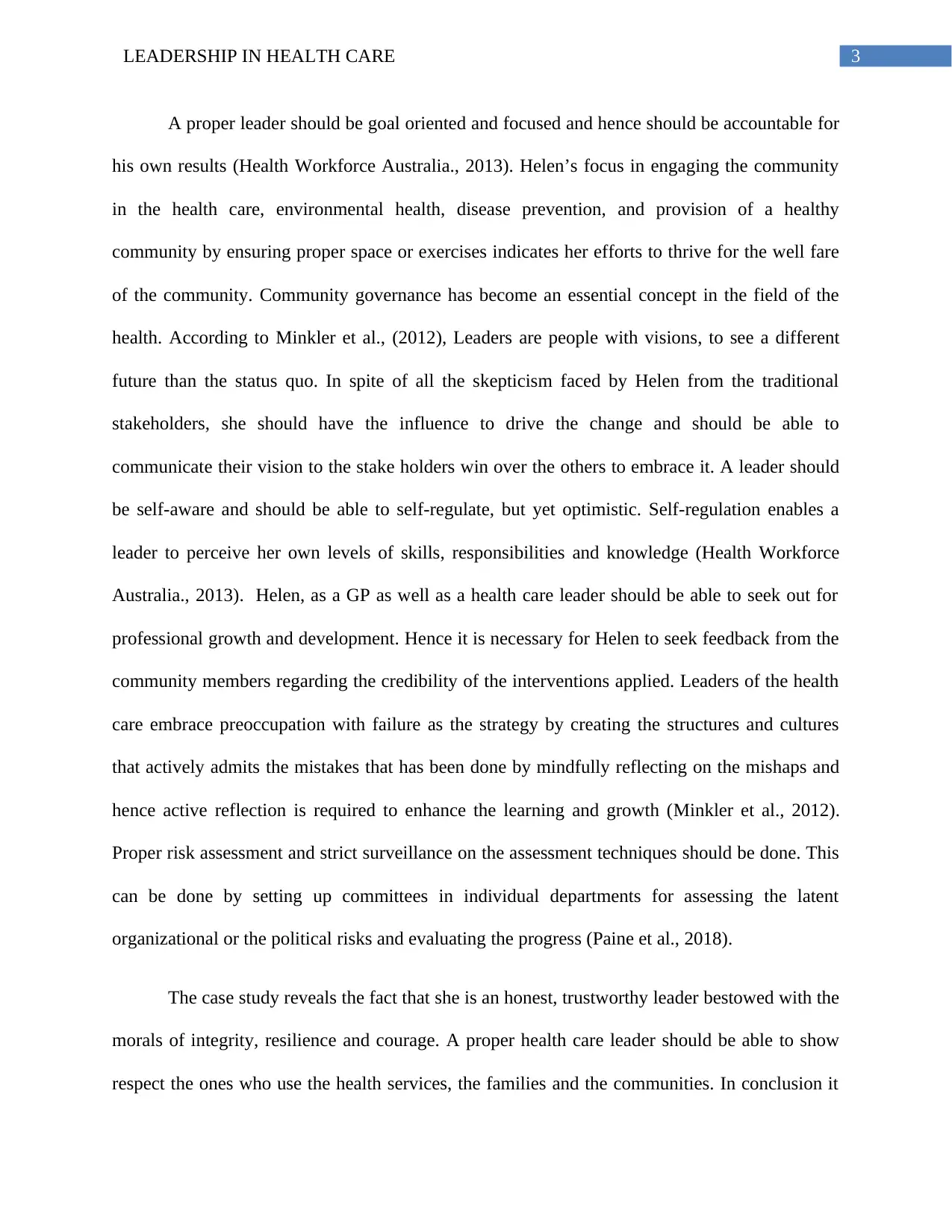
3LEADERSHIP IN HEALTH CARE
A proper leader should be goal oriented and focused and hence should be accountable for
his own results (Health Workforce Australia., 2013). Helen’s focus in engaging the community
in the health care, environmental health, disease prevention, and provision of a healthy
community by ensuring proper space or exercises indicates her efforts to thrive for the well fare
of the community. Community governance has become an essential concept in the field of the
health. According to Minkler et al., (2012), Leaders are people with visions, to see a different
future than the status quo. In spite of all the skepticism faced by Helen from the traditional
stakeholders, she should have the influence to drive the change and should be able to
communicate their vision to the stake holders win over the others to embrace it. A leader should
be self-aware and should be able to self-regulate, but yet optimistic. Self-regulation enables a
leader to perceive her own levels of skills, responsibilities and knowledge (Health Workforce
Australia., 2013). Helen, as a GP as well as a health care leader should be able to seek out for
professional growth and development. Hence it is necessary for Helen to seek feedback from the
community members regarding the credibility of the interventions applied. Leaders of the health
care embrace preoccupation with failure as the strategy by creating the structures and cultures
that actively admits the mistakes that has been done by mindfully reflecting on the mishaps and
hence active reflection is required to enhance the learning and growth (Minkler et al., 2012).
Proper risk assessment and strict surveillance on the assessment techniques should be done. This
can be done by setting up committees in individual departments for assessing the latent
organizational or the political risks and evaluating the progress (Paine et al., 2018).
The case study reveals the fact that she is an honest, trustworthy leader bestowed with the
morals of integrity, resilience and courage. A proper health care leader should be able to show
respect the ones who use the health services, the families and the communities. In conclusion it
A proper leader should be goal oriented and focused and hence should be accountable for
his own results (Health Workforce Australia., 2013). Helen’s focus in engaging the community
in the health care, environmental health, disease prevention, and provision of a healthy
community by ensuring proper space or exercises indicates her efforts to thrive for the well fare
of the community. Community governance has become an essential concept in the field of the
health. According to Minkler et al., (2012), Leaders are people with visions, to see a different
future than the status quo. In spite of all the skepticism faced by Helen from the traditional
stakeholders, she should have the influence to drive the change and should be able to
communicate their vision to the stake holders win over the others to embrace it. A leader should
be self-aware and should be able to self-regulate, but yet optimistic. Self-regulation enables a
leader to perceive her own levels of skills, responsibilities and knowledge (Health Workforce
Australia., 2013). Helen, as a GP as well as a health care leader should be able to seek out for
professional growth and development. Hence it is necessary for Helen to seek feedback from the
community members regarding the credibility of the interventions applied. Leaders of the health
care embrace preoccupation with failure as the strategy by creating the structures and cultures
that actively admits the mistakes that has been done by mindfully reflecting on the mishaps and
hence active reflection is required to enhance the learning and growth (Minkler et al., 2012).
Proper risk assessment and strict surveillance on the assessment techniques should be done. This
can be done by setting up committees in individual departments for assessing the latent
organizational or the political risks and evaluating the progress (Paine et al., 2018).
The case study reveals the fact that she is an honest, trustworthy leader bestowed with the
morals of integrity, resilience and courage. A proper health care leader should be able to show
respect the ones who use the health services, the families and the communities. In conclusion it
Secure Best Marks with AI Grader
Need help grading? Try our AI Grader for instant feedback on your assignments.
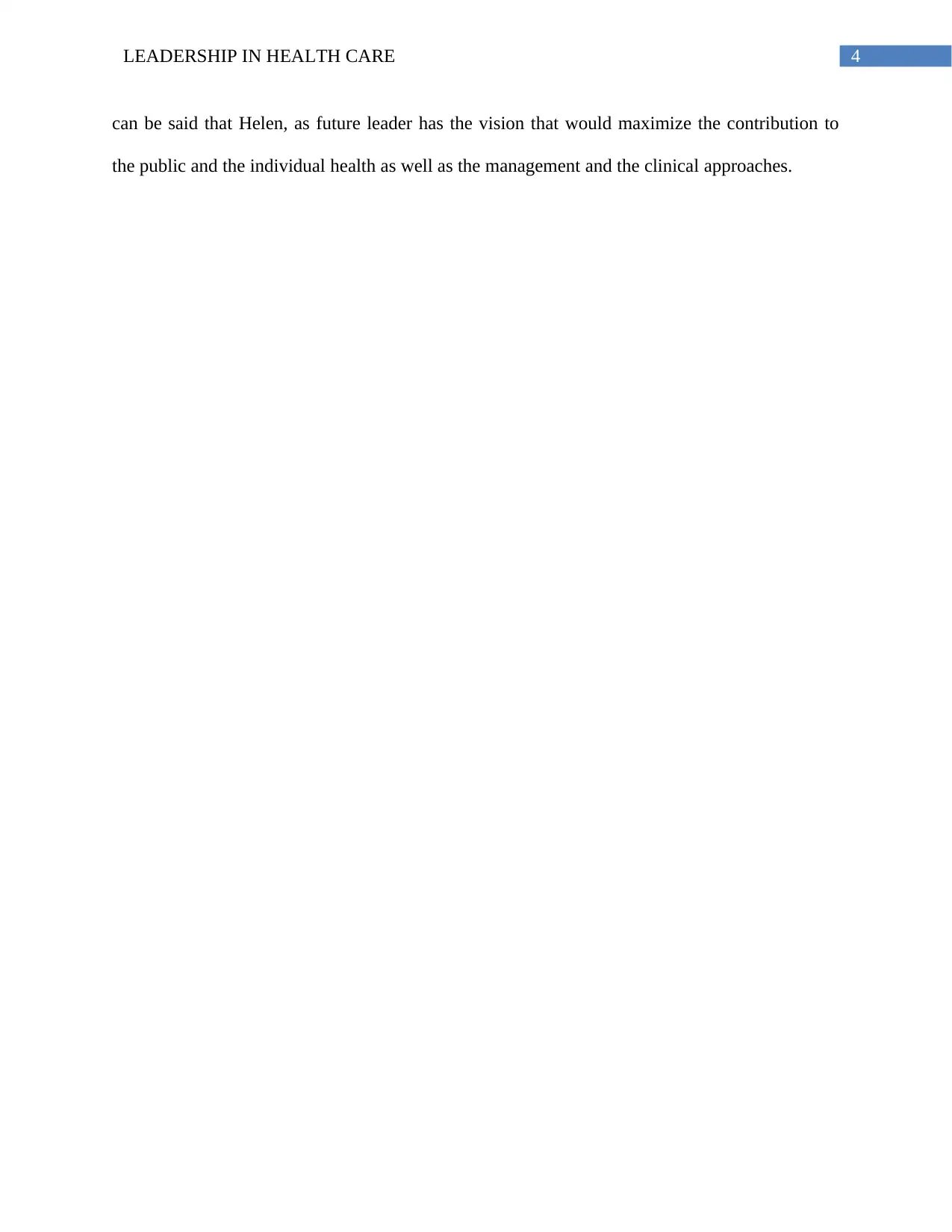
4LEADERSHIP IN HEALTH CARE
can be said that Helen, as future leader has the vision that would maximize the contribution to
the public and the individual health as well as the management and the clinical approaches.
can be said that Helen, as future leader has the vision that would maximize the contribution to
the public and the individual health as well as the management and the clinical approaches.
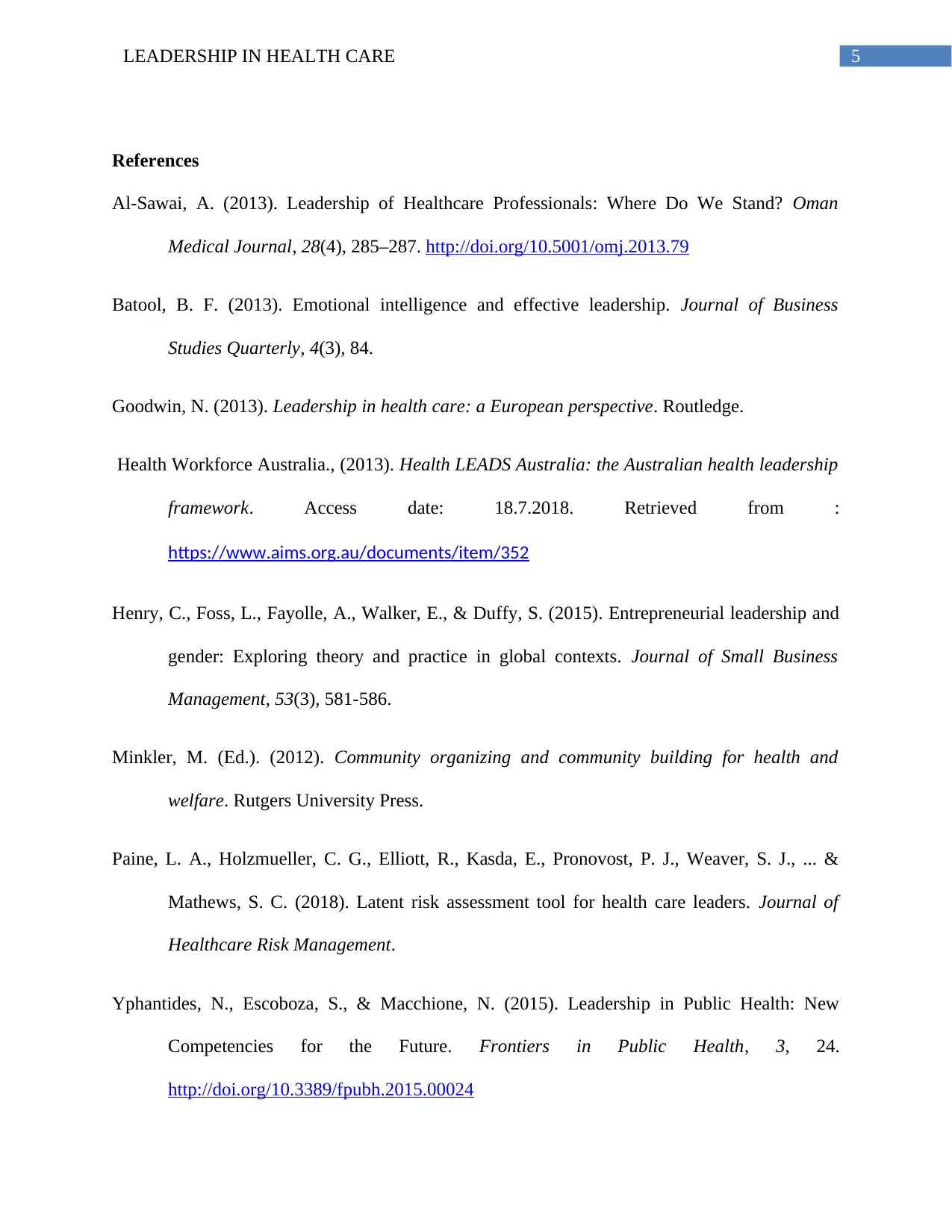
5LEADERSHIP IN HEALTH CARE
References
Al-Sawai, A. (2013). Leadership of Healthcare Professionals: Where Do We Stand? Oman
Medical Journal, 28(4), 285–287. http://doi.org/10.5001/omj.2013.79
Batool, B. F. (2013). Emotional intelligence and effective leadership. Journal of Business
Studies Quarterly, 4(3), 84.
Goodwin, N. (2013). Leadership in health care: a European perspective. Routledge.
Health Workforce Australia., (2013). Health LEADS Australia: the Australian health leadership
framework. Access date: 18.7.2018. Retrieved from :
https://www.aims.org.au/documents/item/352
Henry, C., Foss, L., Fayolle, A., Walker, E., & Duffy, S. (2015). Entrepreneurial leadership and
gender: Exploring theory and practice in global contexts. Journal of Small Business
Management, 53(3), 581-586.
Minkler, M. (Ed.). (2012). Community organizing and community building for health and
welfare. Rutgers University Press.
Paine, L. A., Holzmueller, C. G., Elliott, R., Kasda, E., Pronovost, P. J., Weaver, S. J., ... &
Mathews, S. C. (2018). Latent risk assessment tool for health care leaders. Journal of
Healthcare Risk Management.
Yphantides, N., Escoboza, S., & Macchione, N. (2015). Leadership in Public Health: New
Competencies for the Future. Frontiers in Public Health, 3, 24.
http://doi.org/10.3389/fpubh.2015.00024
References
Al-Sawai, A. (2013). Leadership of Healthcare Professionals: Where Do We Stand? Oman
Medical Journal, 28(4), 285–287. http://doi.org/10.5001/omj.2013.79
Batool, B. F. (2013). Emotional intelligence and effective leadership. Journal of Business
Studies Quarterly, 4(3), 84.
Goodwin, N. (2013). Leadership in health care: a European perspective. Routledge.
Health Workforce Australia., (2013). Health LEADS Australia: the Australian health leadership
framework. Access date: 18.7.2018. Retrieved from :
https://www.aims.org.au/documents/item/352
Henry, C., Foss, L., Fayolle, A., Walker, E., & Duffy, S. (2015). Entrepreneurial leadership and
gender: Exploring theory and practice in global contexts. Journal of Small Business
Management, 53(3), 581-586.
Minkler, M. (Ed.). (2012). Community organizing and community building for health and
welfare. Rutgers University Press.
Paine, L. A., Holzmueller, C. G., Elliott, R., Kasda, E., Pronovost, P. J., Weaver, S. J., ... &
Mathews, S. C. (2018). Latent risk assessment tool for health care leaders. Journal of
Healthcare Risk Management.
Yphantides, N., Escoboza, S., & Macchione, N. (2015). Leadership in Public Health: New
Competencies for the Future. Frontiers in Public Health, 3, 24.
http://doi.org/10.3389/fpubh.2015.00024
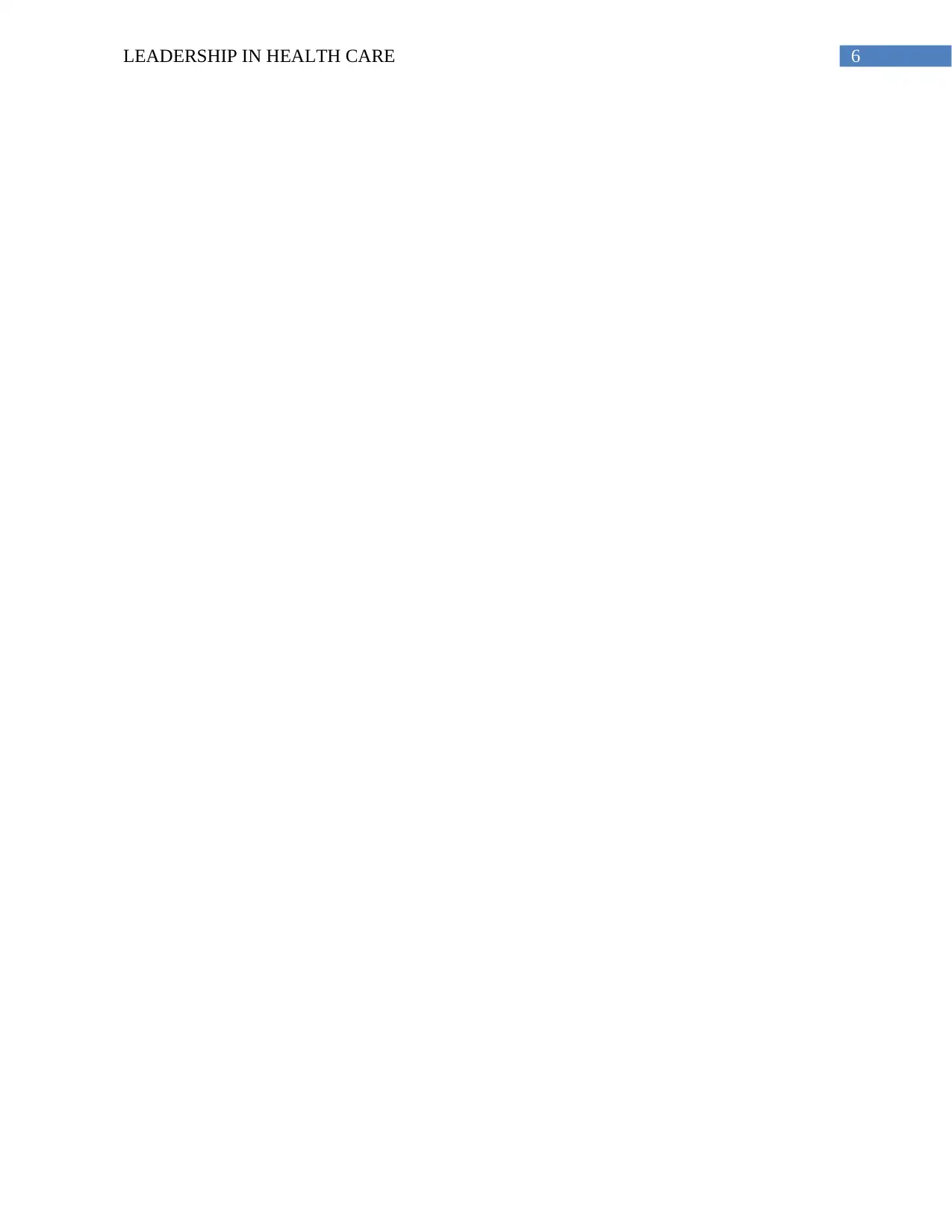
6LEADERSHIP IN HEALTH CARE
Paraphrase This Document
Need a fresh take? Get an instant paraphrase of this document with our AI Paraphraser
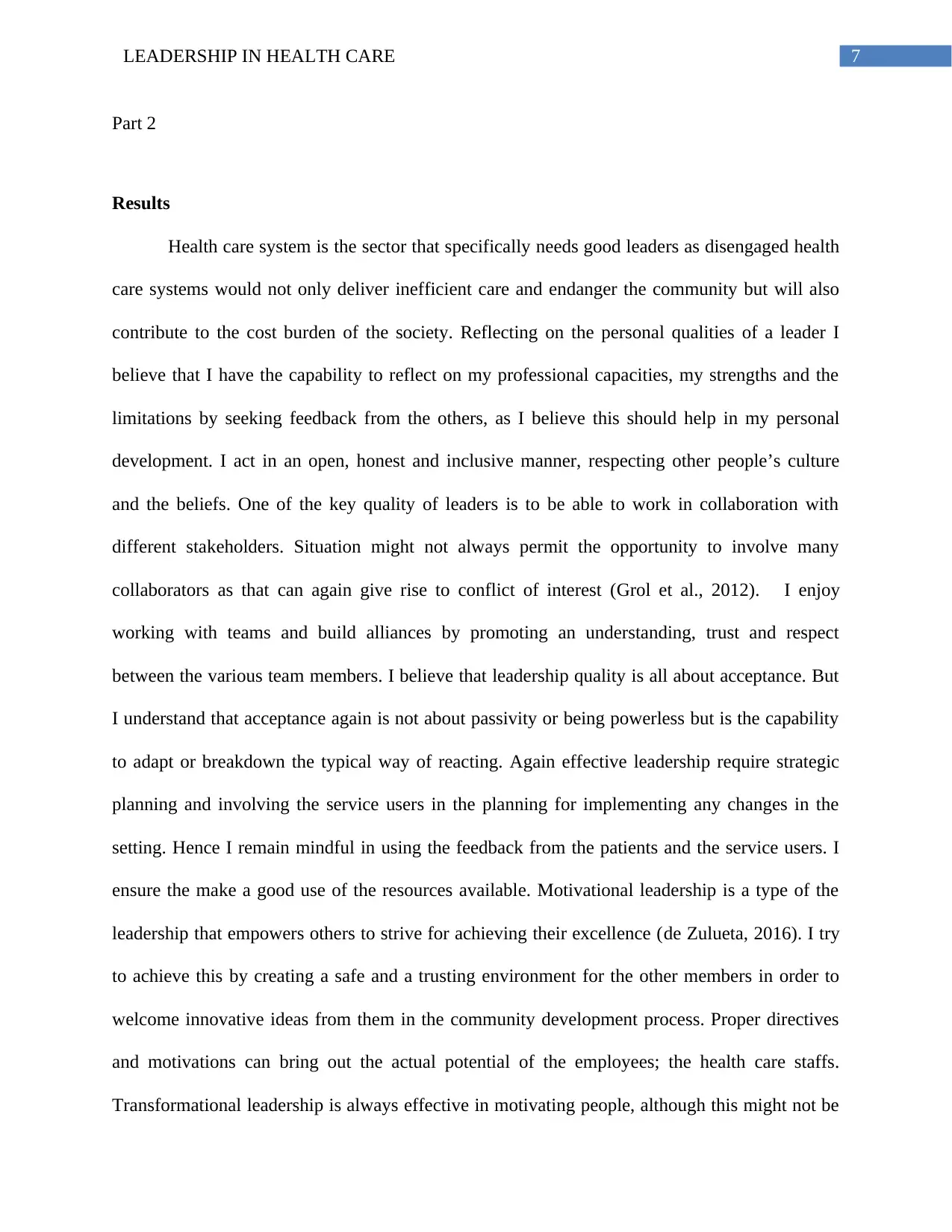
7LEADERSHIP IN HEALTH CARE
Part 2
Results
Health care system is the sector that specifically needs good leaders as disengaged health
care systems would not only deliver inefficient care and endanger the community but will also
contribute to the cost burden of the society. Reflecting on the personal qualities of a leader I
believe that I have the capability to reflect on my professional capacities, my strengths and the
limitations by seeking feedback from the others, as I believe this should help in my personal
development. I act in an open, honest and inclusive manner, respecting other people’s culture
and the beliefs. One of the key quality of leaders is to be able to work in collaboration with
different stakeholders. Situation might not always permit the opportunity to involve many
collaborators as that can again give rise to conflict of interest (Grol et al., 2012). I enjoy
working with teams and build alliances by promoting an understanding, trust and respect
between the various team members. I believe that leadership quality is all about acceptance. But
I understand that acceptance again is not about passivity or being powerless but is the capability
to adapt or breakdown the typical way of reacting. Again effective leadership require strategic
planning and involving the service users in the planning for implementing any changes in the
setting. Hence I remain mindful in using the feedback from the patients and the service users. I
ensure the make a good use of the resources available. Motivational leadership is a type of the
leadership that empowers others to strive for achieving their excellence (de Zulueta, 2016). I try
to achieve this by creating a safe and a trusting environment for the other members in order to
welcome innovative ideas from them in the community development process. Proper directives
and motivations can bring out the actual potential of the employees; the health care staffs.
Transformational leadership is always effective in motivating people, although this might not be
Part 2
Results
Health care system is the sector that specifically needs good leaders as disengaged health
care systems would not only deliver inefficient care and endanger the community but will also
contribute to the cost burden of the society. Reflecting on the personal qualities of a leader I
believe that I have the capability to reflect on my professional capacities, my strengths and the
limitations by seeking feedback from the others, as I believe this should help in my personal
development. I act in an open, honest and inclusive manner, respecting other people’s culture
and the beliefs. One of the key quality of leaders is to be able to work in collaboration with
different stakeholders. Situation might not always permit the opportunity to involve many
collaborators as that can again give rise to conflict of interest (Grol et al., 2012). I enjoy
working with teams and build alliances by promoting an understanding, trust and respect
between the various team members. I believe that leadership quality is all about acceptance. But
I understand that acceptance again is not about passivity or being powerless but is the capability
to adapt or breakdown the typical way of reacting. Again effective leadership require strategic
planning and involving the service users in the planning for implementing any changes in the
setting. Hence I remain mindful in using the feedback from the patients and the service users. I
ensure the make a good use of the resources available. Motivational leadership is a type of the
leadership that empowers others to strive for achieving their excellence (de Zulueta, 2016). I try
to achieve this by creating a safe and a trusting environment for the other members in order to
welcome innovative ideas from them in the community development process. Proper directives
and motivations can bring out the actual potential of the employees; the health care staffs.
Transformational leadership is always effective in motivating people, although this might not be
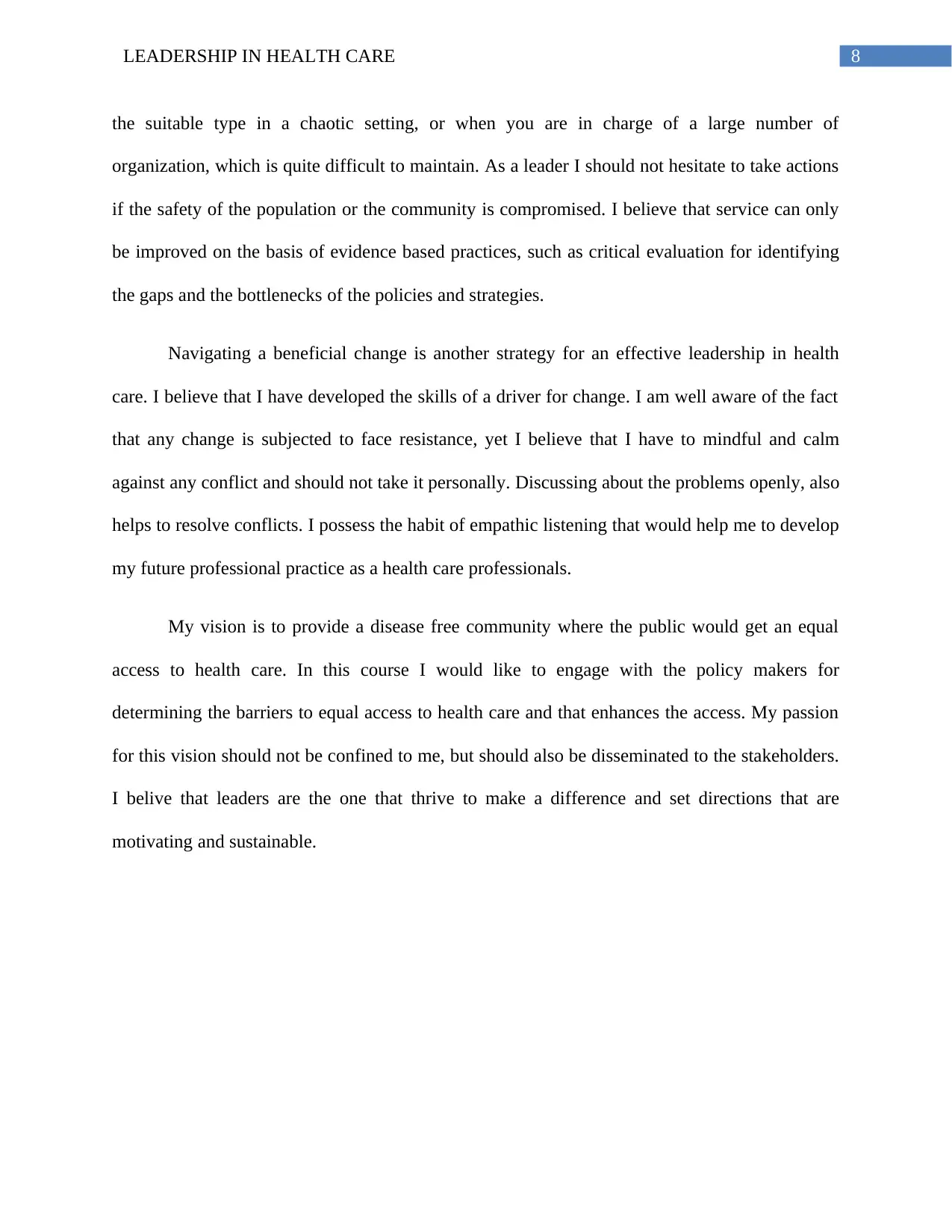
8LEADERSHIP IN HEALTH CARE
the suitable type in a chaotic setting, or when you are in charge of a large number of
organization, which is quite difficult to maintain. As a leader I should not hesitate to take actions
if the safety of the population or the community is compromised. I believe that service can only
be improved on the basis of evidence based practices, such as critical evaluation for identifying
the gaps and the bottlenecks of the policies and strategies.
Navigating a beneficial change is another strategy for an effective leadership in health
care. I believe that I have developed the skills of a driver for change. I am well aware of the fact
that any change is subjected to face resistance, yet I believe that I have to mindful and calm
against any conflict and should not take it personally. Discussing about the problems openly, also
helps to resolve conflicts. I possess the habit of empathic listening that would help me to develop
my future professional practice as a health care professionals.
My vision is to provide a disease free community where the public would get an equal
access to health care. In this course I would like to engage with the policy makers for
determining the barriers to equal access to health care and that enhances the access. My passion
for this vision should not be confined to me, but should also be disseminated to the stakeholders.
I belive that leaders are the one that thrive to make a difference and set directions that are
motivating and sustainable.
the suitable type in a chaotic setting, or when you are in charge of a large number of
organization, which is quite difficult to maintain. As a leader I should not hesitate to take actions
if the safety of the population or the community is compromised. I believe that service can only
be improved on the basis of evidence based practices, such as critical evaluation for identifying
the gaps and the bottlenecks of the policies and strategies.
Navigating a beneficial change is another strategy for an effective leadership in health
care. I believe that I have developed the skills of a driver for change. I am well aware of the fact
that any change is subjected to face resistance, yet I believe that I have to mindful and calm
against any conflict and should not take it personally. Discussing about the problems openly, also
helps to resolve conflicts. I possess the habit of empathic listening that would help me to develop
my future professional practice as a health care professionals.
My vision is to provide a disease free community where the public would get an equal
access to health care. In this course I would like to engage with the policy makers for
determining the barriers to equal access to health care and that enhances the access. My passion
for this vision should not be confined to me, but should also be disseminated to the stakeholders.
I belive that leaders are the one that thrive to make a difference and set directions that are
motivating and sustainable.
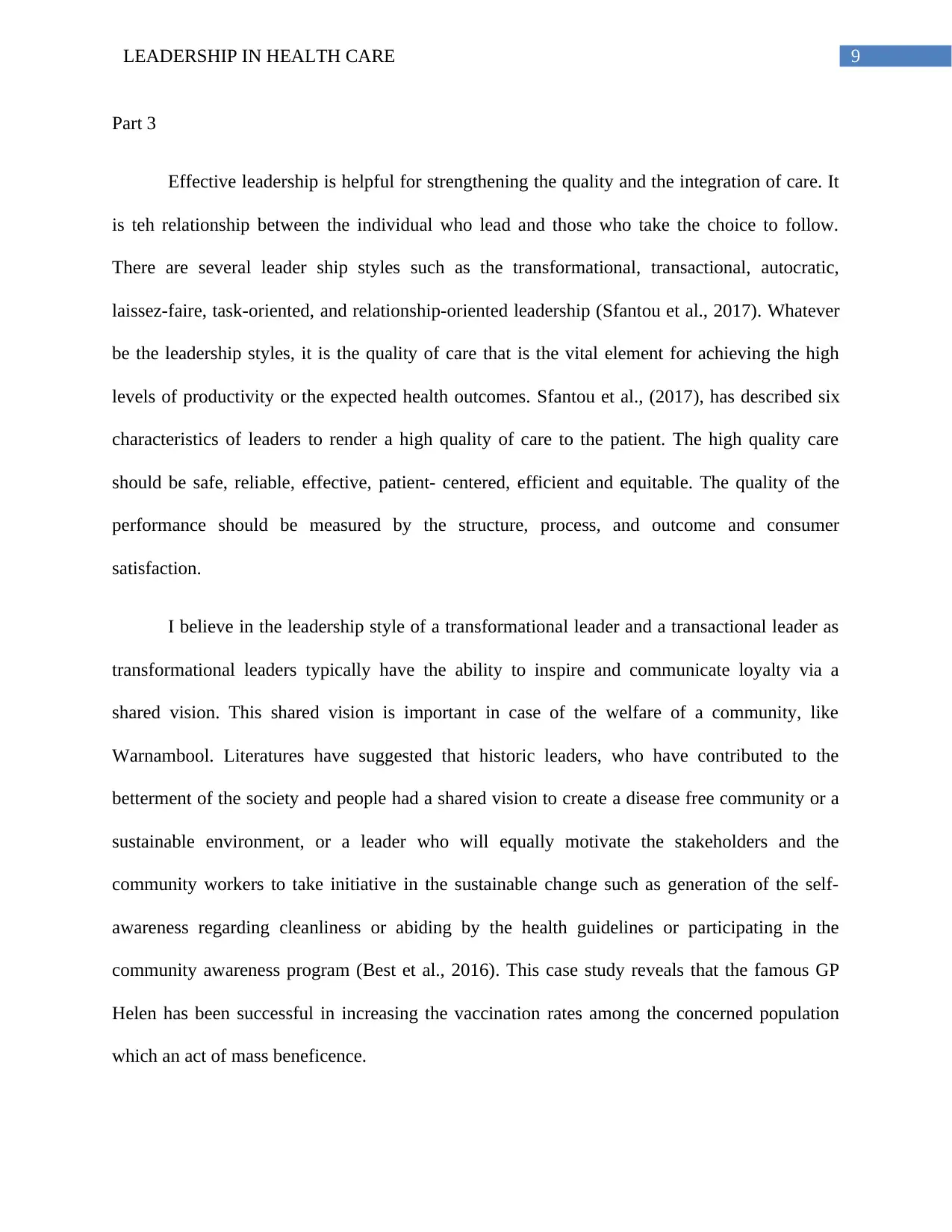
9LEADERSHIP IN HEALTH CARE
Part 3
Effective leadership is helpful for strengthening the quality and the integration of care. It
is teh relationship between the individual who lead and those who take the choice to follow.
There are several leader ship styles such as the transformational, transactional, autocratic,
laissez-faire, task-oriented, and relationship-oriented leadership (Sfantou et al., 2017). Whatever
be the leadership styles, it is the quality of care that is the vital element for achieving the high
levels of productivity or the expected health outcomes. Sfantou et al., (2017), has described six
characteristics of leaders to render a high quality of care to the patient. The high quality care
should be safe, reliable, effective, patient- centered, efficient and equitable. The quality of the
performance should be measured by the structure, process, and outcome and consumer
satisfaction.
I believe in the leadership style of a transformational leader and a transactional leader as
transformational leaders typically have the ability to inspire and communicate loyalty via a
shared vision. This shared vision is important in case of the welfare of a community, like
Warnambool. Literatures have suggested that historic leaders, who have contributed to the
betterment of the society and people had a shared vision to create a disease free community or a
sustainable environment, or a leader who will equally motivate the stakeholders and the
community workers to take initiative in the sustainable change such as generation of the self-
awareness regarding cleanliness or abiding by the health guidelines or participating in the
community awareness program (Best et al., 2016). This case study reveals that the famous GP
Helen has been successful in increasing the vaccination rates among the concerned population
which an act of mass beneficence.
Part 3
Effective leadership is helpful for strengthening the quality and the integration of care. It
is teh relationship between the individual who lead and those who take the choice to follow.
There are several leader ship styles such as the transformational, transactional, autocratic,
laissez-faire, task-oriented, and relationship-oriented leadership (Sfantou et al., 2017). Whatever
be the leadership styles, it is the quality of care that is the vital element for achieving the high
levels of productivity or the expected health outcomes. Sfantou et al., (2017), has described six
characteristics of leaders to render a high quality of care to the patient. The high quality care
should be safe, reliable, effective, patient- centered, efficient and equitable. The quality of the
performance should be measured by the structure, process, and outcome and consumer
satisfaction.
I believe in the leadership style of a transformational leader and a transactional leader as
transformational leaders typically have the ability to inspire and communicate loyalty via a
shared vision. This shared vision is important in case of the welfare of a community, like
Warnambool. Literatures have suggested that historic leaders, who have contributed to the
betterment of the society and people had a shared vision to create a disease free community or a
sustainable environment, or a leader who will equally motivate the stakeholders and the
community workers to take initiative in the sustainable change such as generation of the self-
awareness regarding cleanliness or abiding by the health guidelines or participating in the
community awareness program (Best et al., 2016). This case study reveals that the famous GP
Helen has been successful in increasing the vaccination rates among the concerned population
which an act of mass beneficence.
Secure Best Marks with AI Grader
Need help grading? Try our AI Grader for instant feedback on your assignments.
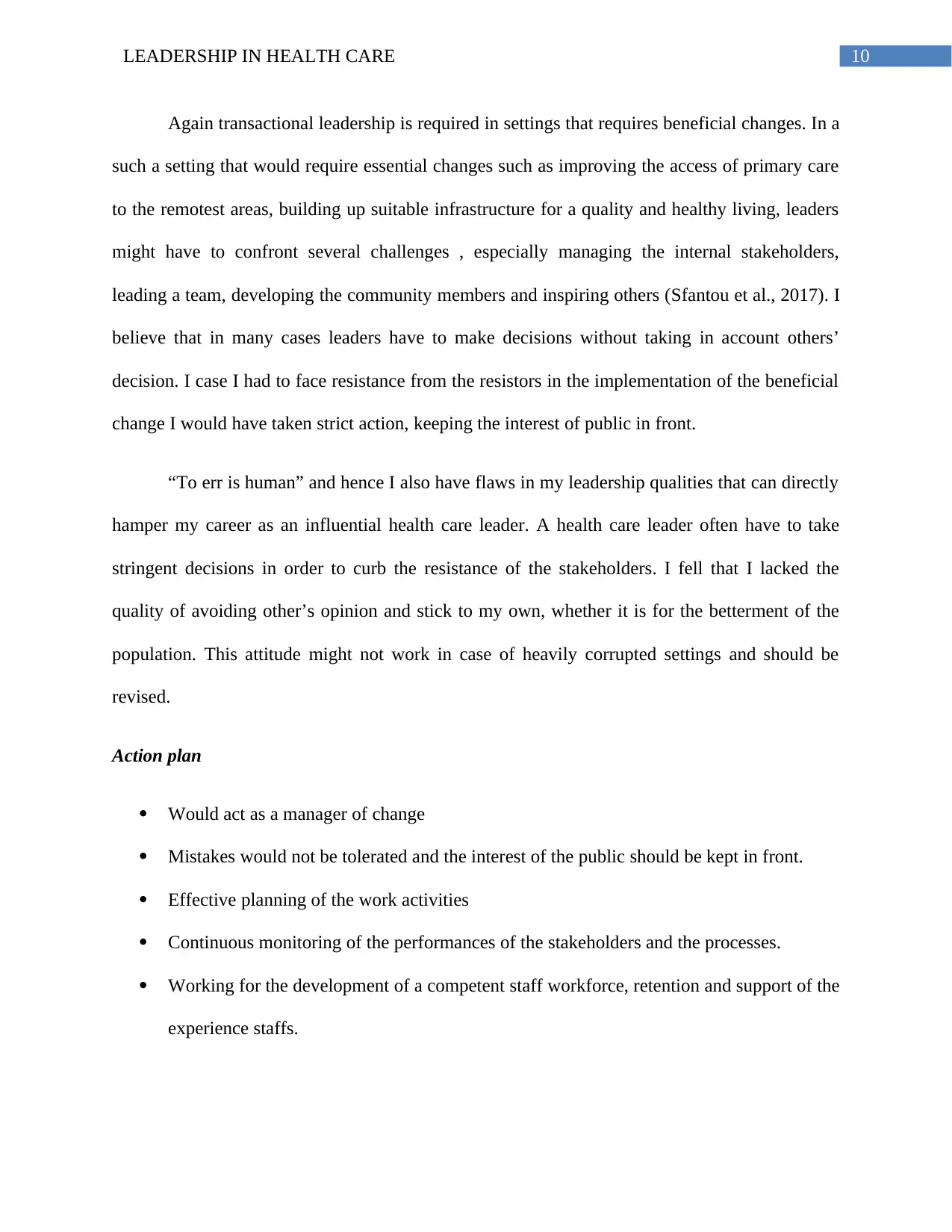
10LEADERSHIP IN HEALTH CARE
Again transactional leadership is required in settings that requires beneficial changes. In a
such a setting that would require essential changes such as improving the access of primary care
to the remotest areas, building up suitable infrastructure for a quality and healthy living, leaders
might have to confront several challenges , especially managing the internal stakeholders,
leading a team, developing the community members and inspiring others (Sfantou et al., 2017). I
believe that in many cases leaders have to make decisions without taking in account others’
decision. I case I had to face resistance from the resistors in the implementation of the beneficial
change I would have taken strict action, keeping the interest of public in front.
“To err is human” and hence I also have flaws in my leadership qualities that can directly
hamper my career as an influential health care leader. A health care leader often have to take
stringent decisions in order to curb the resistance of the stakeholders. I fell that I lacked the
quality of avoiding other’s opinion and stick to my own, whether it is for the betterment of the
population. This attitude might not work in case of heavily corrupted settings and should be
revised.
Action plan
Would act as a manager of change
Mistakes would not be tolerated and the interest of the public should be kept in front.
Effective planning of the work activities
Continuous monitoring of the performances of the stakeholders and the processes.
Working for the development of a competent staff workforce, retention and support of the
experience staffs.
Again transactional leadership is required in settings that requires beneficial changes. In a
such a setting that would require essential changes such as improving the access of primary care
to the remotest areas, building up suitable infrastructure for a quality and healthy living, leaders
might have to confront several challenges , especially managing the internal stakeholders,
leading a team, developing the community members and inspiring others (Sfantou et al., 2017). I
believe that in many cases leaders have to make decisions without taking in account others’
decision. I case I had to face resistance from the resistors in the implementation of the beneficial
change I would have taken strict action, keeping the interest of public in front.
“To err is human” and hence I also have flaws in my leadership qualities that can directly
hamper my career as an influential health care leader. A health care leader often have to take
stringent decisions in order to curb the resistance of the stakeholders. I fell that I lacked the
quality of avoiding other’s opinion and stick to my own, whether it is for the betterment of the
population. This attitude might not work in case of heavily corrupted settings and should be
revised.
Action plan
Would act as a manager of change
Mistakes would not be tolerated and the interest of the public should be kept in front.
Effective planning of the work activities
Continuous monitoring of the performances of the stakeholders and the processes.
Working for the development of a competent staff workforce, retention and support of the
experience staffs.
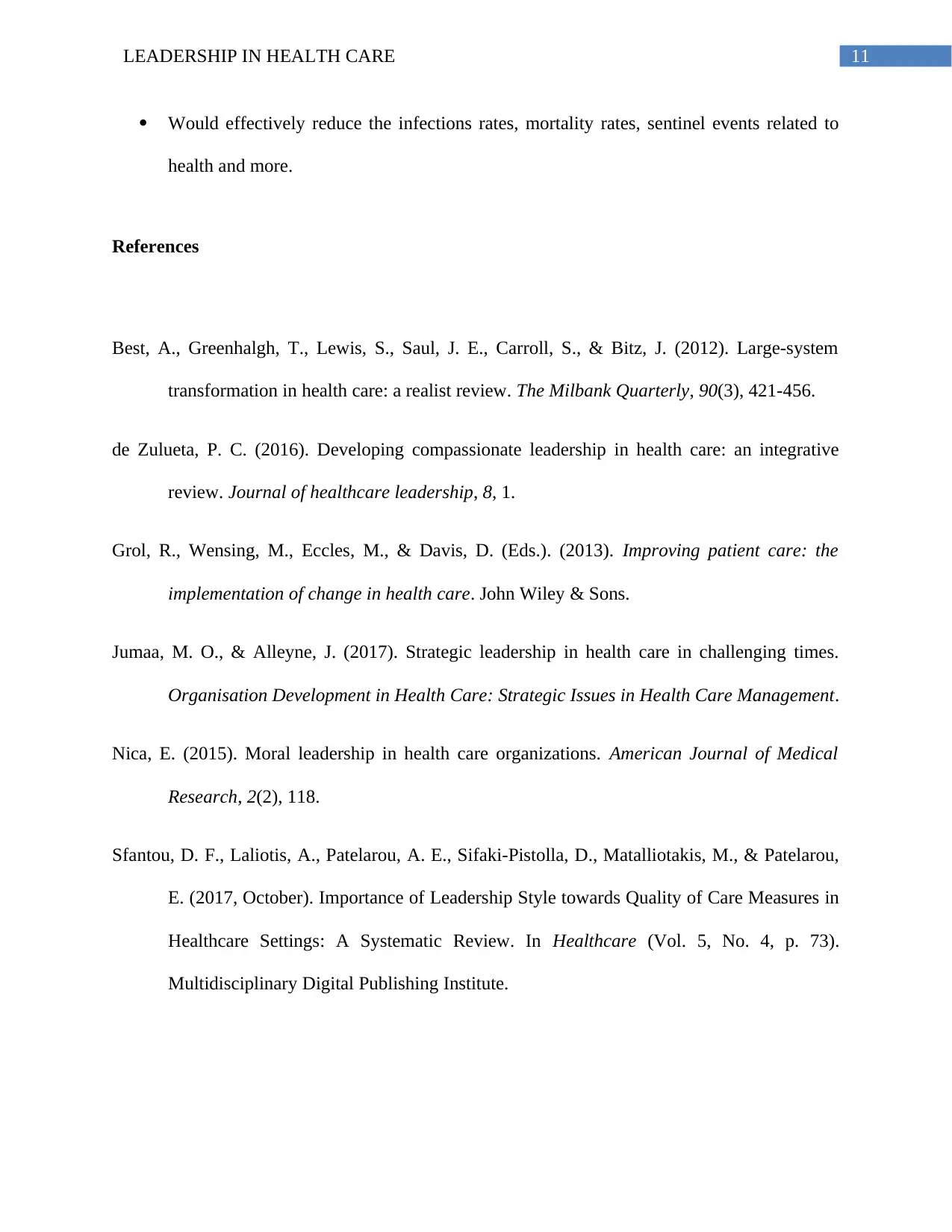
11LEADERSHIP IN HEALTH CARE
Would effectively reduce the infections rates, mortality rates, sentinel events related to
health and more.
References
Best, A., Greenhalgh, T., Lewis, S., Saul, J. E., Carroll, S., & Bitz, J. (2012). Large‐system
transformation in health care: a realist review. The Milbank Quarterly, 90(3), 421-456.
de Zulueta, P. C. (2016). Developing compassionate leadership in health care: an integrative
review. Journal of healthcare leadership, 8, 1.
Grol, R., Wensing, M., Eccles, M., & Davis, D. (Eds.). (2013). Improving patient care: the
implementation of change in health care. John Wiley & Sons.
Jumaa, M. O., & Alleyne, J. (2017). Strategic leadership in health care in challenging times.
Organisation Development in Health Care: Strategic Issues in Health Care Management.
Nica, E. (2015). Moral leadership in health care organizations. American Journal of Medical
Research, 2(2), 118.
Sfantou, D. F., Laliotis, A., Patelarou, A. E., Sifaki-Pistolla, D., Matalliotakis, M., & Patelarou,
E. (2017, October). Importance of Leadership Style towards Quality of Care Measures in
Healthcare Settings: A Systematic Review. In Healthcare (Vol. 5, No. 4, p. 73).
Multidisciplinary Digital Publishing Institute.
Would effectively reduce the infections rates, mortality rates, sentinel events related to
health and more.
References
Best, A., Greenhalgh, T., Lewis, S., Saul, J. E., Carroll, S., & Bitz, J. (2012). Large‐system
transformation in health care: a realist review. The Milbank Quarterly, 90(3), 421-456.
de Zulueta, P. C. (2016). Developing compassionate leadership in health care: an integrative
review. Journal of healthcare leadership, 8, 1.
Grol, R., Wensing, M., Eccles, M., & Davis, D. (Eds.). (2013). Improving patient care: the
implementation of change in health care. John Wiley & Sons.
Jumaa, M. O., & Alleyne, J. (2017). Strategic leadership in health care in challenging times.
Organisation Development in Health Care: Strategic Issues in Health Care Management.
Nica, E. (2015). Moral leadership in health care organizations. American Journal of Medical
Research, 2(2), 118.
Sfantou, D. F., Laliotis, A., Patelarou, A. E., Sifaki-Pistolla, D., Matalliotakis, M., & Patelarou,
E. (2017, October). Importance of Leadership Style towards Quality of Care Measures in
Healthcare Settings: A Systematic Review. In Healthcare (Vol. 5, No. 4, p. 73).
Multidisciplinary Digital Publishing Institute.
1 out of 12
Related Documents
Your All-in-One AI-Powered Toolkit for Academic Success.
+13062052269
info@desklib.com
Available 24*7 on WhatsApp / Email
![[object Object]](/_next/static/media/star-bottom.7253800d.svg)
Unlock your academic potential
© 2024 | Zucol Services PVT LTD | All rights reserved.





